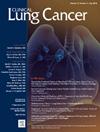接受免疫疗法的 NSCLC 患者中与高级别 irAEs 相关的基因突变
IF 3.3
3区 医学
Q2 ONCOLOGY
引用次数: 0
摘要
目的与低度虹膜睫状体异常相比,高度虹膜睫状体异常通常具有剂量限制性,并可能改变患者的长期治疗方案。材料与方法我们对2015年至2022年期间在一家综合癌症中心接受免疫检查点抑制剂(ICI)治疗的430例III期和IV期非小细胞肺癌(NSCLC)患者进行了一项回顾性研究,这些患者接受了化疗或未接受化疗。研究小组检索了测序数据和完整的临床信息,包括详细的irAEs病历。采用费雪精确检验来确定突变与是否存在高级别虹膜睫状体异常之间的关联。结果分别有15.2%和46.2%的患者发生了高级别和低级别虹膜睫状体异常。呼吸道和胃肠道虹膜不良反应是最常见的两种虹膜不良反应。在接受 ICI 和 ICI+ 化疗的患者中,出现或未出现 irAEs 的患者分布情况相似。通过分析基因突变数据,我们发现5个基因(MYC、TEK、FANCA、FAM123B和MET)的突变与高级别虹膜睫状体异常风险的增加相关。对于腺癌亚型,TEK、MYC、FGF19、RET和MET的突变与高级别虹膜睫状体异常相关;而对于鳞癌亚型,ERBB2的突变与高级别虹膜睫状体异常相关。本文章由计算机程序翻译,如有差异,请以英文原文为准。
Mutations Associated With High-Grade irAEs in NSCLC Patients Receiving Immunotherapies
Objectives
Compared to low-grade irAEs, high-grade irAEs are more often dose-limiting and can alter the long-term treatment options for a patient. Predicting the incidence of high-grade irAEs would help with treatment selection and therapeutic drug monitoring.
Materials and methods
We performed a retrospective study of 430 stage III and IV patients with non-small cell lung cancer (NSCLC) who received an immune checkpoint inhibitor (ICI), either with or without chemotherapy, at a single comprehensive cancer center from 2015 to 2022. The study team retrieved sequencing data and complete clinical information, including detailed irAEs medical records. Fisher's exact test was used to determine the association between mutations and the presence or absence of high-grade irAEs. Patients were analyzed separately based on tumor subtypes and sequencing platforms.
Results
High-grade and low-grade irAEs occurred in 15.2% and 46.2% of patients, respectively. Respiratory and gastrointestinal irAEs were the 2 most common irAEs. The distribution of patients with or without irAEs was similar between ICI and ICI+chemotherapy-treated patients. By analyzing the mutation data, we identified 5 genes (MYC, TEK, FANCA, FAM123B, and MET) with mutations that were correlated with an increased risk of high-grade irAEs. For the adenocarcinoma subtype, mutations in TEK, MYC, FGF19, RET, and MET were associated with high-grade irAEs; while for the squamous subtype, ERBB2 mutations were associated with high-grade irAEs.
Conclusion
This study is the first to demonstrate that specific tumor mutations correlate with the incidence of high-grade irAEs in patients with NSCLC treated with an ICI, providing molecular guidance for treatment selection and drug monitoring.
求助全文
通过发布文献求助,成功后即可免费获取论文全文。
去求助
来源期刊

Clinical lung cancer
医学-肿瘤学
CiteScore
7.00
自引率
2.80%
发文量
159
审稿时长
24 days
期刊介绍:
Clinical Lung Cancer is a peer-reviewed bimonthly journal that publishes original articles describing various aspects of clinical and translational research of lung cancer. Clinical Lung Cancer is devoted to articles on detection, diagnosis, prevention, and treatment of lung cancer. The main emphasis is on recent scientific developments in all areas related to lung cancer. Specific areas of interest include clinical research and mechanistic approaches; drug sensitivity and resistance; gene and antisense therapy; pathology, markers, and prognostic indicators; chemoprevention strategies; multimodality therapy; and integration of various approaches.
 求助内容:
求助内容: 应助结果提醒方式:
应助结果提醒方式:


